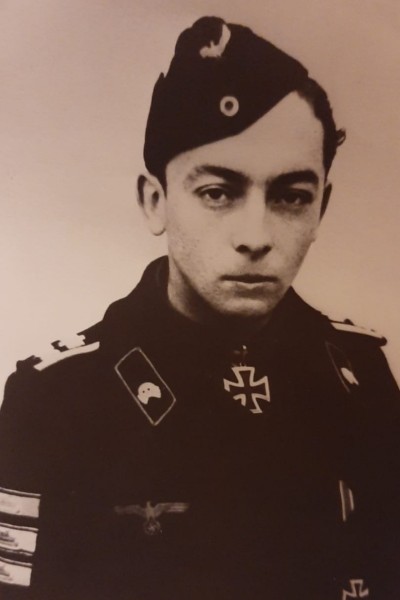Fink, Josef
- Date of birth:
- January 12th, 1925 (Stetten/Württemberg, Germany)
- Date of death:
- March 19th, 1986 (Burladingen/Baden-Württemberg, Germany)
- Nationality:
- German
Biography
Do you have more information about this person? Inform us!
- Period:
- Second World War (1939-1945)
- Rank:
- Gefreiter (Lance Corporal)
- Unit:
- Gruppenführer, Panzer-Grenadier-Bataillon 2106, Panzer-Brigade 106 "Feldherrnhalle", Heer
- Awarded on:
- December 9th, 1944
“I destroyed 7 Sherman tanks in this way… With Panzerfaust and Tellermine during the battle for an Upper Alsatian village:
The Wehrmachtbericht of the 09.12.1944 reported that ‘Gefreiter Josef Fink of the Panzerbrigade 106 ‘Feldherrnhalle’ destroyed 7 Sherman tanks in 24 hours via close combat weapons during the defensive fighting in Upper Alsace.’ For his bravery Gefreiter (by now Unteroffizier) Fink was awarded the Knight’s Cross to the Iron Cross. He provides us with this first-hand account of the action…
“During the afternoon of the 01.12.1944 my squad and I were in position in a fruit garden just before the entrance to Erstein (near Schlettstadt), along the road to Strasbourg. Here I saw how 2 Sherman tanks wished to penetrate into the village from the East. I jumped out of my trench and ran behind them in their blind spot so as to take them from the front. At the first house I hit the first enemy tank in the motor with a Panzerfaust fired from a range of 6 metres, and it burned out. I dodged into the fruit garden beside the house and destroyed the second tank (which was behind a pear tree) with another Panzerfaust from 15 metres’ range. The crews of both tanks burned up. During this incident light artillery fire was being laid onto the village.
On the 02.12.1944 the urban combat in Ernstein [no typo] flowed back and forth the entire day. But with time the village fell into the hands of the North Americans. The Zug that I belonged to initially stood in reserve, but was then dispatched to retake the village in a counterattack. I had worked my way to the centre of the village with my squad while under heavy artillery fire when I heard motor noises and multiple shots from a farm along the village road. I broke into a barn from the rear and crept to the door. As I cautiously opened it, a Sherman tank that was firing on our Sturmgeschütze was located just 2 metres away. I saw how an officer was observing from his cupola. As I came out of the barn I received machine-pistol fire from the top floor of the farmhouse. I threw a hand grenade through the roof panel that the fire was coming from. When the officer in the tank saw me he shot, but did not hit anything. I however shot my Panzerfaust at the tank and totally destroyed it.
After this my squad followed suit and, after swiftly crossing the village road, entered the graveyard that the Americans had occupied. We received strong fire, and so my men took cover at the wall along the graveyard. I personally worked my way forward and pushed the Americans back with hand grenades. But then US tanks entered the area and opened fire themselves. In order to engage them I pushed a stone against the graveyard wall and stood atop of it. In this way I destroyed a tank with a Panzerfaust. I fought the crew with my machine-pistol as they tried to get out. The US infantry had meanwhile vacated the graveyard.
I once again assembled my squad and we pushed past the burning tank to the village edge. There I let my men get into position. After this I crept alone towards the somewhat distant burning sugar factory in order to check it out. There I encountered an enemy signals troop, which I forced back with machine-pistol fire.
I destroyed the remaining tanks during the fluid battles in and around the village. I can’t remember the precise details as it all took place in a blur. I only know that in one case I placed a Tellermine beside the turret of a tank and let it detonate. I destroyed 2 more tanks shortly afterwards with Panzerfausts. All tanks burned out. After this the remaining tanks pulled back, and the US infantry likewise vacated the village save for a few scattered squads. Until then the battle had lasted for about 2-3 hours. During the clearing of the village I received a pistol shot in the left forearm over the course of the night. Since the 09.12.1944 I found myself in a reserve hospital.””
- Period:
- Second World War (1939-1945)
- Period:
- Second World War (1939-1945)
- Period:
- Second World War (1939-1945)
- Period:
- Second World War (1939-1945)
- Period:
- Second World War (1939-1945)
Sources
- Photo 1: Michael
- - BENDER, R.J. & BREYETTE T.,, Tank Killers.
- FELLGIEBEL, W.P., Elite of theThird Reich, Helion & Company Limited, Solihull, 2003.
- HUß, JüRGEN & SONDERMANN, HEINZ-WERNER, Ritterkreuzträger im Mannschaftsstand 1941-1945, VDM Heinz Nickel, Zweibrücken, 2009.
- THOMAS, FRANZ & WEGMANN, GüNTER, Die Ritterkreuzträger der Deutschen Wehrmacht 1939-1945, Biblio Verlag, Bissendorf, 2003.
- Die Ordensträger der Deutschen Wehrmacht (CD), VMD-Verlag GmbH, Osnabrück, 2002







